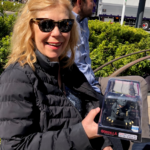Adventures in Chile explore the varied topography of desert to the north and glaciers & tundras in the south. The middle of Chile has very Mediterranean-like conditions with mild winters and warm, dry summers which is conducive to fertile valleys and vineyards.
It is a narrow country with the Andes mountain range to the east and the Pacific Ocean on the west. Having described Chile, you can see that there are many activities for the outdoor adventurer such as hiking, kayaking, fly fishing, rafting and horseback riding to name a few. But if you are not very active or are slower getting around, I can tell you from my experience there is still plenty you can do to enjoy and do in this very beautiful country.
To start your Chilean vacation, you will fly into Santiago, which is the capital and economic center of Chile as well as its political and cultural center. All flights lead in and out of the capital. Santiago is a mix of old and new, with Spanish and French Colonial buildings & churches, alongside new modern buildings, including Latin America’s tallest skyscraper.
There are a variety of neighborhoods that can be explored on foot, where you will discover galleries, museums, design shops, markets and places to dine. Each neighborhood has it’s own flavor and personality. One tour I recommend is a city tour, so you can become familiar with the different areas that includes Plaza De Armas, Constitution Square and a ride to San Cristobal Hill for a panoramic view the city.
The Singular Santiago, one of our preferred hotels here, is located in the Lastarria & Bellas Artes area, which is a wonderful neighborhood in which to find restaurants and the city’s best ice cream parlor. People are out and about enjoying this area of the city. Another hotel which just opened recently is Ladera, a very modern boutique hotel in the Providencia residential neighborhood, where you can walk two blocks to Sculpture Park that lines the Machupo River running through the heart of the city, and two blocks from the new funicular that can transport you to the top of San Cristobal Hill. Providencia is the new up & coming area in Santiago.
From Santiago one can enjoy day trips to Isla Negra to visit the Neruda Museum, to Valparaiso to see the city which was named a UNESCO World Heritage Site. If you want to visit a winery there are many just beyond an hour’s drive from the city. A winery I recommend for a visit is Matetic, where you can partake in wine-tasting of local wines as well as have a farm-to-table lunch at their restaurant, El Emporio. Matetic also operates a small boutique resort we can reserve for our guests, a delightful place to spend a night prior to taking the red-eye flight home.
From Santiago, going north to Atacama involves a little over a 2-hour flight to Calama. From there it is a 1 ½ hour drive to Alto Atacama Desert Lodge & Spa, just outside of the town of San Pedro de Atacama. Alto Atacama is an all-inclusive property with it’s ‘Andescape’ concept executed by Veronica Poblete, who followed the concept of an Andean Park, paying tribute to the traditional landscaping of the Altiplano. There are a variety of excursions offered by the lodge and led by trained local & knowledgeable guides. Here you can go hiking, biking, horseback riding and star-gazing to name a few, or just luxuriate on the grounds and enjoy the pool and spa facilities.
As a person who is not very physically active or agile, I found that there are numerous choices to experience the natural beauty and culture of Chile. The guides are very helpful and observant of everyone in the group and willing to assist when necessary. One of the tours I took was to the Atacama Salt Flats to see the flamingos gathering at sunset. There is walking involved, but it is on marked paths through the salt flats on level ground. It was not difficult and the guide allowed me to walk at my own pace and would stop at points of interest to give us information on what we were viewing.
The other excursion I took was to the Altiplanic lagoons of Laguna Miscanti & Laguna Menique, located over 13,000 feet above sea level. The hike was along a pretty flat path to the lagoon, and is easy to walk on with magnificent scenery all around you. Because of the altitude I had to walk slowly and stop to catch my breath offering me a chance to look around and take some fantastic photos. In fact, all visitors to Atacama will take a day or two to get acclimated to the altitude here. The guide again stayed close by and shared his knowledge of the wildlife and flora native to the area. I must say that Altiplanic lagoons were so beautiful with the contrast of the deep blue lagoons, mountains with snow caps and the clear blue skies. A minimum three-night, though ideally four-night stay is desirable here.
After visiting Atacama, we headed south to Patagonia after a stop-over in Santiago. The Holiday Inn Santiago Airport is located just outside of the terminal making a short overnight stay quite convenient. The hotel is very clean with large rooms, a nice restaurant and includes breakfast.
After a 3 ½ hour morning flight from Santiago to Punta Arenas, you arrive in Patagonia to a part of Chile that is so very different from Atacama. Here you are in the land of fjords and glaciers hidden among green forests and lakes. The 2 ½ hour ride to Porto Bories is different as you see part of the Magellan Strait, sheep and horse ranches or estancias,
as well as some of the native wildlife such as guanaco, condors, rheas, mora eagles and flamingos. When you arrive at The Singular Patagonia, you will be amazed at the property which is listed as a National Monument. The hotel overlooks the Senoret Sea Channel which is the gateway to Tores Del Paine National Park, the reason most people visit Patagonia.
The Singular offers excursions for all levels of agility and can be ½ day or full day tours.
The Historic Museum & Industrial tour of the hotel museum and grounds gives you the history of Porto Bories and the Frigorifico Puerto Bories which dates back to 1905. The plant was restored by fourth generation family members of the original pioneers, who lovingly converted it into a museum and hotel. The museum shows the ‘Post Victorian Industrial’ architectural style and features examples of British machinery reflecting the technology of the early 20th century.
The ½ day tour to Serrano and Balmaceda Glaciers via the hotel’s boat is a great way to see the topography of Patagonia, weather permitting. The hardest part of the tour for some may be getting in and out of the boat, but again, the guides are very helpful in assisting those who need help. After cruising through some of the Patagonian Fjords we stopped at Bernardo O’Higgins National Park, where you take a hike along a narrow uphill trail to Glacier Serrano. If you don’t want to or are unable to hike the short trail to the viewpoint overlooking beautiful Glacier Serrano, there is a wonderful deck where you can sit, see the glacier and listen to the melt-water flowing into the channel. After the hike you head back to the boat to The Singular where you will observe the scenery and if lucky, the wildlife.
We saw waterfalls, hanging glaciers, and cormorants enroute.
The full day tour I took, Discovering Torres Del Paine National Park, is an amazing excursion to see what some people call the 8th wonder of the world. On the drive north to the entrance of the park, you stop at several lookout points with views of Paine Massif. Talk about photo-ops! You will also be on the lookout for the typical fauna, local animals such as nandus, guanacos, armadillos and pumas if you are luck enough, and the stunning glacial lakes of various colors. A short hike at Grey Lake Beach may bring you in front of icebergs and calving glaciers. Again, the guides are well trained and keep track of everyone, especially the slower walkers.
Even though I am not an agile walker, I was still able to go on a variety of excursions in
Chile. I must admit, the best part of being a slow walker was stopping to take some amazing photos of such a unique destination.



